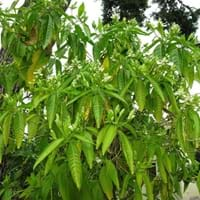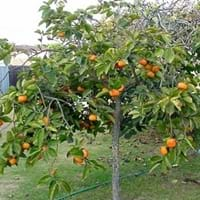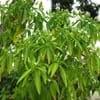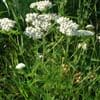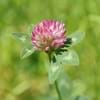Life Span
Perennial
Perennial
Type
Herbs, Perennial
Tree
Origin
South-Eastern Asia
China, Japan
Types
Not Available
Not Available
Habitat
Semi desert, Wet forest
Subtropical climates, Warmer regions
USDA Hardiness Zone
9-11
6-10
AHS Heat Zone
12 - 9
10-7
Sunset Zone
Not Available
H1, 6, 7, 8, 9, 12, 14, 15, 16, 18, 19, 20, 21, 22, 23, 24
Habit
Clump-Forming
Pyramidal
Minimum Width
Not Available
Flower Color
White
Light Yellow
Flower Color Modifier
Bicolor
Bicolor
Fruit Color
Not Available
Orange
Leaf Color in Spring
Dark Green
Green
Leaf Color in Summer
Green, Light Green
Green
Leaf Color in Fall
Dark Green
Yellow, Burgundy, Orange Red
Leaf Color in Winter
Dark Green
Not Available
Leaf Shape
Elliptic
Ovate
Plant Season
Spring, Summer, Fall, Winter
Summer, Fall, Winter
Sunlight
Full Sun, Partial Sun, Partial shade
Full Sun, Partial Sun
Growth Rate
Very Fast
Medium
Type of Soil
Clay, Loam, Sand
Clay, Loam
The pH of Soil
Acidic, Neutral, Alkaline
Acidic, Neutral
Soil Drainage
Average
Well drained
Bloom Time
Indeterminate
Summer
Tolerances
Wet Site
Not Available
Where to Plant?
Container, Ground
Ground
How to Plant?
Stem Cutting
Seedlings, Stem Planting
Plant Maintenance
Medium
Medium
Watering Requirements
Average Water Needs, Needs good drainage
Requires watering in the growing season, Water occasionally
In Summer
Lots of watering
Lots of watering
In Spring
Moderate
Moderate
In Winter
Average Water
Average Water
Soil pH
Acidic, Neutral, Alkaline
Acidic, Neutral
Soil Type
Clay, Loam, Sand
Clay, Loam
Soil Drainage Capacity
Average
Well drained
Sun Exposure
Full Sun, Partial Sun, Partial shade
Full Sun, Partial Sun
Pruning
Cut away fading foliage, Cut upper 1/3 section when young to enhancegrowth, Remove damaged leaves, Remove dead branches, Remove dead leaves
Remove damaged leaves, Remove dead branches, Remove dead leaves, Requires very little pruning
Fertilizers
All-Purpose Liquid Fertilizer, Don't use high pH fertilizers
General garden fertilizer
Pests and Diseases
Aphids, Downy mildew, Dry root rot, Rust, Spider mites
Mealybugs
Plant Tolerance
Heat Tolerance, Humidity
Not Available
Flowers
Showy
Insignificant
Flower Petal Number
Single
Single
Foliage Texture
Medium
Medium
Foliage Sheen
Matte
Glossy
Self-Sowing
No
Not Available
Attracts
Aphids, Bees, Butterflies, Snails
Birds
Allergy
Dizziness, Mouth itching, Vomiting
Not Available
Aesthetic Uses
Cottage Garden, Showy Purposes
Not Available
Beauty Benefits
Good Cleanser, Good for the Scalp
Not Available
Environmental Uses
Air purification, Insect Repellent
Air purification
Medicinal Uses
Antipyretic, Bronchitis, Cough, Digestive disorders, Ear infections, Expectorant, Laxative, Migraines, Piles, Rheumatism, Throat infection, Treating fever
Not Available
Part of Plant Used
Bark, Leaf Stalks, Leaves
Fruits
Other Uses
Biomass for fuel, Can be made into a herbal tea, Culinary use, Oil is used for aromatherapy, Used as a laxative
Culinary use, Used As Food
Used As Indoor Plant
No
No
Used As Outdoor Plant
Yes
Yes
Garden Design
Container, Hedges, Mixed Border, Screening / Wind Break, Tropical
Feature Plant, Fruit / Fruit Tree, Topiary / Bonsai / Espalier
Botanical Name
Justicia adhatoda
DIOSPYROS kaki 'Fuyu'
Common Name
Malabar nut, Adulsa, Adhatoda, Vasaka
Asian Persimmon, Fuyu Persimmon, Japanese Persimmon, Kaki
In Hindi
अडुळसा, अडुसा
Fuyu ख़ुरमा
In German
Indisches Lungenkraut
Fuyu Persimmon
In French
Justicia adhatoda
Fuyu Persimmon
In Spanish
Justicia adhatoda
Fuyu caqui
In Greek
Justicia adhatoda
Fuyu Λωτός
In Portuguese
Justicia adhatoda
Fuyu Persimmon
In Polish
Justicia adhatoda
Fuyu Persimmon
In Latin
Justicia adhatoda
Persimmon Impromptus
Phylum
Magnoliophyta
Tracheophyta
Class
Magnoliopsida
Magnoliopsida
Order
Scrophulariales
Ericales
Family
Acanthaceae
Ebenaceae
Clade
Angiosperms, Monocots
Angiosperms, Asterids, Eudicots
Tribe
Justicieae
Not Available
Subfamily
Acanthoideae
Not Available
Number of Species
Not Available
Importance of Malabar nut and Fuyu Persimmon
Want to have the most appropriate plant for your garden? You might want to know the importance of Malabar nut and Fuyu Persimmon. Basically, these two plants vary in many aspects. Compare Malabar nut and Fuyu Persimmon as they differ in many characteristics such as their life, care, benefits, facts, etc. Every gardener must at least have the slightest clue about the plants he wants to plant in his garden. Compare their benefits, which differ in many ways like facts and uses. The medicinal use of Malabar nut is Antipyretic, Bronchitis, Cough, Digestive disorders, Ear infections, Expectorant, Laxative, Migraines, Piles, Rheumatism, Throat infection and Treating fever whereas of Fuyu Persimmon is Not Available. Malabar nut has beauty benefits as follows: Good Cleanser and Good for the Scalp while Fuyu Persimmon has beauty benefits as follows: Good Cleanser and Good for the Scalp.
Compare Facts of Malabar nut vs Fuyu Persimmon
How to choose the best garden plant for your garden depending upon its facts? Here garden plant comparison will help you to solve this query. Compare the facts of Malabar nut vs Fuyu Persimmon and know which one to choose. As garden plants have benefits and other uses, allergy is also a major drawback of plants for some people. Allergic reactions of Malabar nut are Dizziness, Mouth itching and Vomiting whereas of Fuyu Persimmon have Not Available respectively. Having a fruit bearing plant in your garden can be a plus point of your garden. Malabar nut has no showy fruits and Fuyu Persimmon has showy fruits. Also Malabar nut is not flowering and Fuyu Persimmon is not flowering . You can compare Malabar nut and Fuyu Persimmon facts and facts of other plants too.
